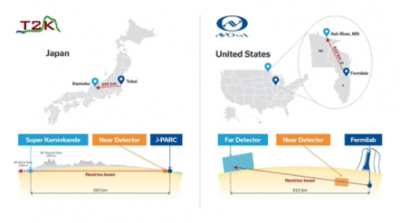STONY BROOK, NY — October 22 2025 –-The State University of New York at Stony Brook researchers from the Department of Physics and Astronomy, are part of an international team of physicists conducting the T2K (Tokai to Kamioka) experiment and have provided joint analysis with another team of physicists conducting a different NOvA (NOvA is NuMI Off-axis νe Appearance) experiment. The combined team studied long-baseline neutrino oscillations utilizing the data sets taken by both experiments using powerful accelerators and state-of-art detectors. By leveraging the different baselines and energy spectra of the two experiments, the team achieved enhanced precision measurements of neutrino oscillations. The results from this joint analysis will be published in the journal Nature on Wednesday, October 22, 2025.
As a result of the joint analysis, the combined team succeeded in reducing the uncertainty in the differences between neutrino masses to below 2%. Although the ordering of the three neutrino masses is still unknown, the results show that depending on this ordering, the magnitude of Charge Conjugation and Parity (CP) symmetry violation—a difference in behavior between particles and antiparticles—would be strongly constrained.
This achievement marks an important step toward uncovering CP symmetry violation in neutrinos and the origin of the matter–antimatter asymmetry in the universe. The joint analysis combined ten years of T2K data collected since 2010 and six years of NOvA data collected since 2014, and it also demonstrates the strength of collaboration between two international experiments that are competitive yet complementary.
“I truly commend both NOvA and the T2K collaborations seeing this through despite many technical and political challenges during the joint analysis process,” said Chang Kee Jung, Distinguished Professor and Chair of the Department of Physics and Astronomy. “The initial discussion of a possible joint analysis started more than 10 years ago and the first NOvA-T2K meeting was held in March 2016. Thus, it has been a really long process. The outstanding and informative results obtained from this joint analysis are products of strong desires of both collaborations to maximize the scientific output from their experiments in advancing human knowledge. It is an exemplary model of inter-experimental collaboration. Stony Brook has been the Principal Investigator institution for the T2K United States group since the inception of the T2K experiment and has made numerous and significant contributions to the experiment, including this joint analysis.”
While these first joint results do not definitively resolve any remaining unknowns of neutrinos, they do significantly enhance physicists’ detailed knowledge about neutrinos. Plus, they look to validate the impressive collaborative effort between the two competing — yet complementary — experiments.
The T2K collaboration, which is powered by the J-PARC facility, has more than 560 members from 75 institutions (including Stony Brook University) in 15 countries and includes other US institutions: Boston University; Duke University; Lawrence Berkeley National Laboratory; Louisiana State University; Michigan State University; South Dakota School of Mines and Technology; Stanford Linear Accelerator Center (SLAC); University of California, Irvine; University of Colorado, Boulder; University of Houston; University of Minnesota; University of Pennsylvania; University of Pittsburgh; and University of Rochester. The US group’s participation in the T2K experiment is supported by the US Department of Energy.
The NOvA collaboration, which is managed by Fermi National Accelerator Laboratory, consists of more than 250 scientists and engineers from 49 institutions in eight countries. The collaboration by NOvA and T2K began active work on this joint analysis in 2019. Both experiments continue to take data, and efforts are already underway to update the joint analysis with the new data.
NOvA and T2K are the only currently operating long-baseline neutrino experiments. Their Initial combined results have laid a foundation for forthcoming neutrino experiments that will look to answer the questions around neutrinos unambiguously.
# # #
About The State University of New York at Stony Brook
The State University of New York at Stony Brook is New York’s flagship university and No. 1 public university. It is part of the State University of New York (SUNY) system. With more than 27,000 students, more than 3,000 faculty members, more than 225,000 alumni, a premier academic healthcare system and 18 NCAA Division I athletic programs, Stony Brook is a research-intensive distinguished center of innovation dedicated to addressing the world’s biggest challenges. The university embraces its mission to provide comprehensive undergraduate, graduate and professional education of the highest quality, and is ranked as the #59 overall university and #26 among public universities in the nation by U.S. News & World Report’s Best Colleges listing. Fostering a commitment to academic research and intellectual endeavors, Stony Brook’s membership in the Association of American Universities (AAU) places it among the top 71 research institutions in North America. The university’s distinguished faculty have earned esteemed awards such as the Nobel Prize, Pulitzer Prize, Indianapolis Prize for animal conservation, Abel Prize, Fields Medal and Breakthrough Prizes in Mathematics and Physics. Stony Brook has the responsibility of co-managing Brookhaven National Laboratory for the U.S. Department of Energy — one of only eight universities with a role in running a national laboratory. In 2023, Stony Brook was named the anchor institution for The New York Climate Exchange on Governors Island in New York City. Providing economic growth for neighboring communities and the wider geographic region, the university totals an impressive $8.93 billion in increased economic output on Long Island. Follow us on Facebook https://www.facebook.com/stonybrooku/ and X@stonybrooku.
